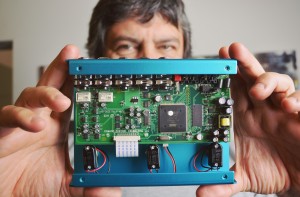
Analog Designer Gregg Stock
In addition to being a co-founder of Strymon, Gregg Stock is the man behind the analog circuit design in every Strymon product. Recently, he was kind enough to
Free US Shipping On Orders Over $49
Easy 30-Day Returns
Financing Available Through ![]()

We recently pulled Strymon’s own Marketing / Noisemaking guru Ethan Tufts away from his marketing duties and asked him about his own personal music making setup. He spends most of his live shows creating loops and songs in real-time, and has what seems to be a rather complex rig. Let’s hear more about it!
I noticed you have two pedalboards. What’s going on here?
Yes, I have one pedalboard on the floor, primarily for guitar. The other is at waist-level on a keyboard stand. This one is used for audio I/O, MIDI control, vocal effects, and a place to put my MacBook!
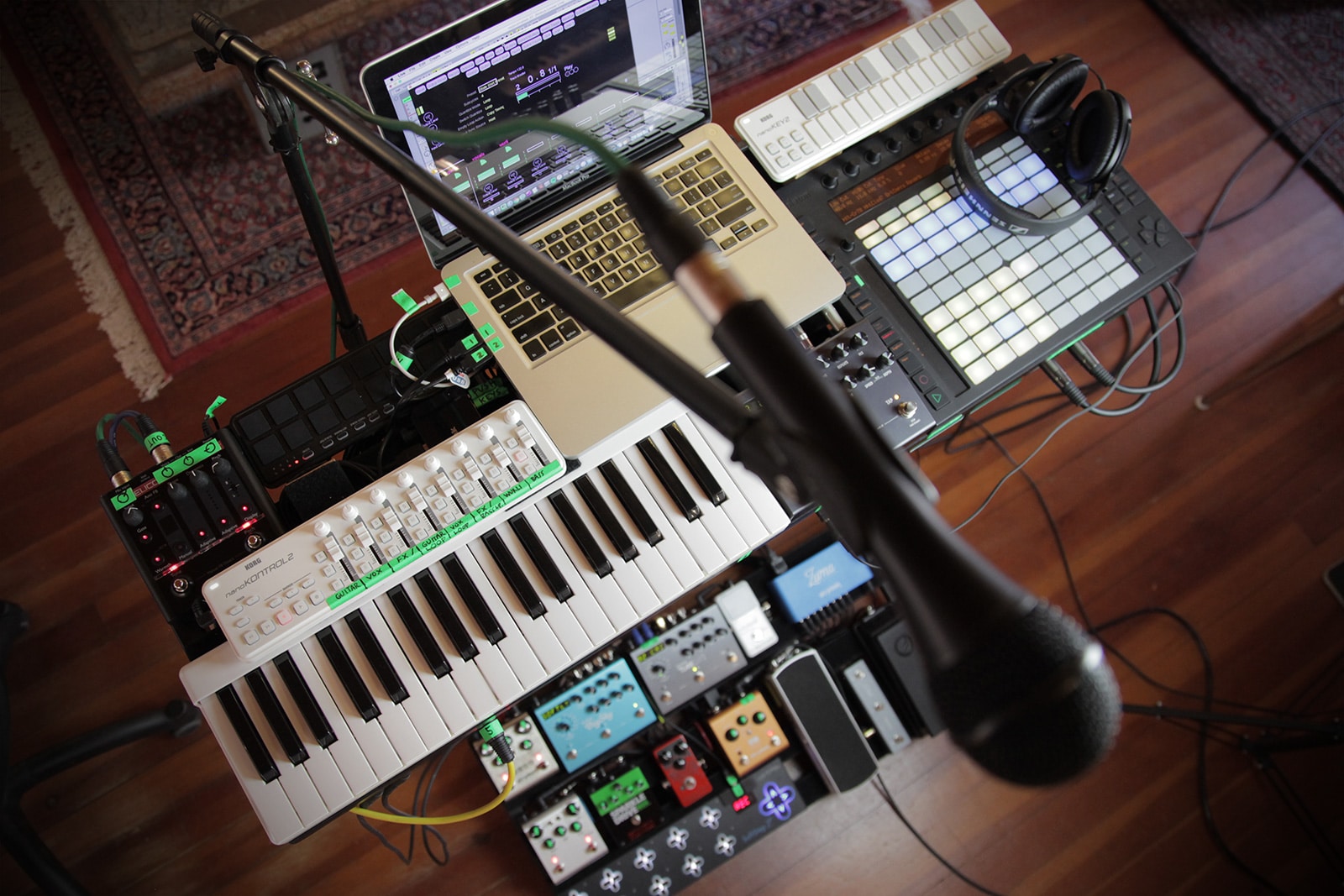
I play solo live looping shows, with vocals, guitar, synths, and drum machines. My rig gives me access to a wide range of simultaneous sounds, and the tools needed to create live performances where all music is created in real time. Nothing is prerecorded.
What’s on your raised pedalboard?
This is the State Shirt looper mission control tower! The core of my rig is this amazing software looper called Circular Labs Möbius (not to be confused with Strymon Mobius). It’s running as a plug-in within Ableton Live on my old MacBook Pro.
Audio for my guitar, vocals, and Ableton tones are routed into the looper. This board also contains all of the audio I/O, MIDI controllers to access looping functions, an Ableton Push for drum machine and synth control, as well as pedals for vocal and synth effects processing.

I had been using hardware loopers for the last 10-15 years or so, most recently a pair of Gibson/Oberheim Echoplex Digital Pro units. They are great, but I wanted to push my looping a bit further, have more I/O options, and easily synchronize stuff within Live. Then I discovered Circular Labs Möbius. The learning curve is very steep but it’s like having eight Echoplex Digital Pro units in one. It’s insane.
The board itself is a PedalTrain Terra 42 that I modified to hold gear on the bottom as well. Some scrap metal, loads of zip ties, and fluorescent green spike tape round out the “elegant” look!

What is your vocal signal chain?
I most often use an Audix OM9 microphone because it has very good feedback rejection, which is essential if you’re looping vocals. Audio is routed into a TC Helicon VoiceTone Correct XT, then into the Presonus Firestudio Project. Dry vocals get sent to the house PA via a Radial Pro D2 direct box, and also routed through an Effects Send to the TimeLine, and then back into Ableton Live. I also route some keyboard sounds to the TimeLine and back into Live.
Tell us about your guitar pedalboard.
This board changes quite frequently. The signal path now is: Strymon OB.1 (always on) » Ernie Ball VP Jr. » Earthquaker Devices Crimson Drive » Voodoo Lab Sparkle Drive Mod » Strymon “amp-in-a-box” prototype » Strymon TimeLine, Strymon BigSky » Strymon Deco. The signal chain is mono until TimeLine, and then runs stereo through BigSky and Deco. Audio is routed into Ableton Live via a Presonus Firestudio Project connected to my MacBook Pro. The “amp-in-a-box” prototype is something that we put together for our Strymon Social demo boards. It has a built-in cab simulation, which allows my guitar to go direct into a full-range PA. Power is provided by a Strymon Zuma, which we’re extensively testing before we ship.
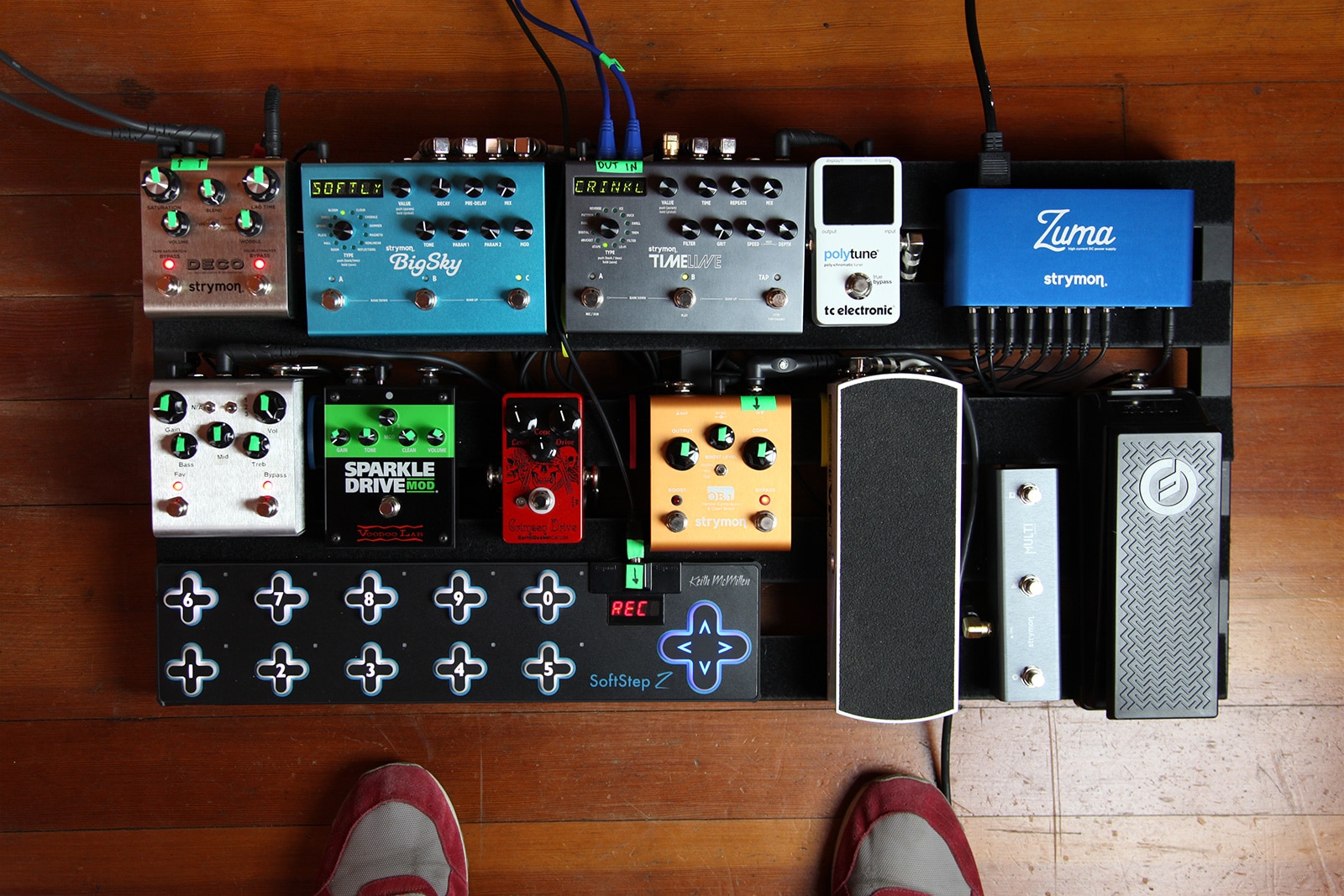
I’ve got MIDI running from Ableton Live into both TimeLine pedals, allowing my delay tempo to sync with my song tempo. I’m also using a Strymon MultiSwitch for TimeLine preset selection, a TC Polytune, a Moog expression pedal to control my vocal TimeLine, and a Keith McMillen SoftStep 2 for MIDI control of Circular Labs Möbius looping software.
What guitar are you using?
I most often use my mid-1990s Mexican-made Fender Toronado for my live shows. Best $250 I ever spent!

What MIDI devices are you using?
The Keith McMillen SoftStep 2 is set up to control 10 of my looping and performance functions: Record, Overdub, Undo, Multiply, Mute, Loop 1, Loop 2, Loop 3, Loop 4, Drum Mute/Unmute. I’m using a Korg nanoKONTROL2 for control over Ableton Live track levels, mute, and unmute. The Ableton Push is used primarily for programming drum beats in real time. I also have a no-name 37-key MIDI keyboard for control over Live sounds, quite often a Wurlitzer or synth bass sound. A Korg nanoKEY is used to control iZotope Stutter Edit and chop up my vocals and guitar sounds in real time. Lastly, I’ve mapped some looper utility functions to the keys on a Korg nanoPAD—resetting the looper, resetting loop start points, etc.
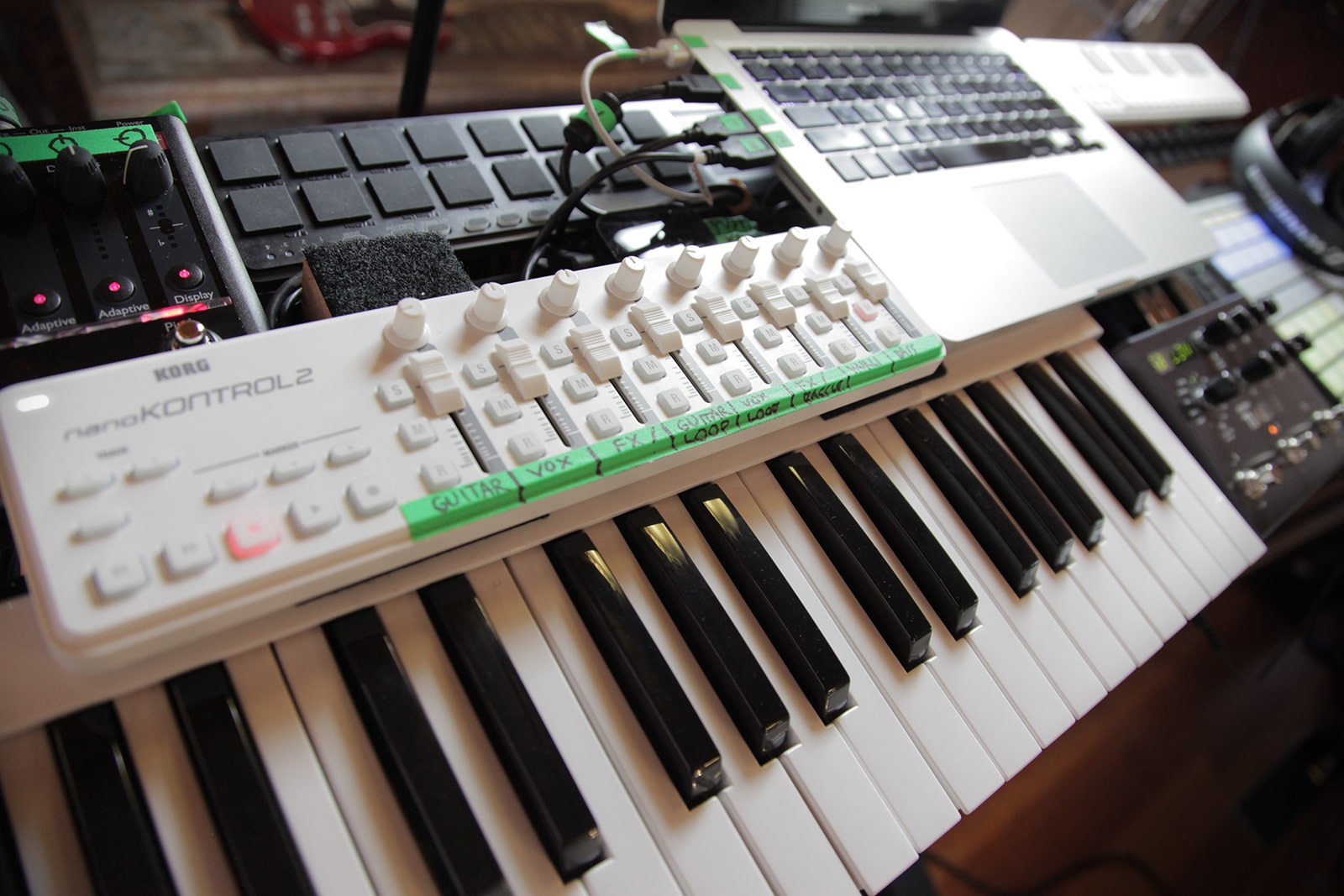
How do you make all of this work?
Each instrument input, whether it be guitar, vocals, or anything else, is routed into Ableton Live. Each signal is sent to the master output (house PA) and to the Circular Labs Möbius looper plug-in. Input monitoring on the looper is turned off. Guitar is sent to track 1 of the looper, vocals sent to track 2, etc. This allows me to record and loop each instrument separately, to control each loop separately, and to have control over where each individual looped signal gets sent. Most often it gets routed through a direct box to the house PA, but I can also route guitar and looped guitar into an amp instead of the PA.
I set up the looper to be able to record four separate loops per track input. This is critical in being able to record multiple song sections (intro, verse, chorus, bridge, etc). I also have them set up to be sychronized with each other, so when I press play Loop 1, each track will start playing simultaneously. Lastly, all of this is synced to Ableton Live’s tempo, allowing the the synchronization of a drum machine or other MIDI events.
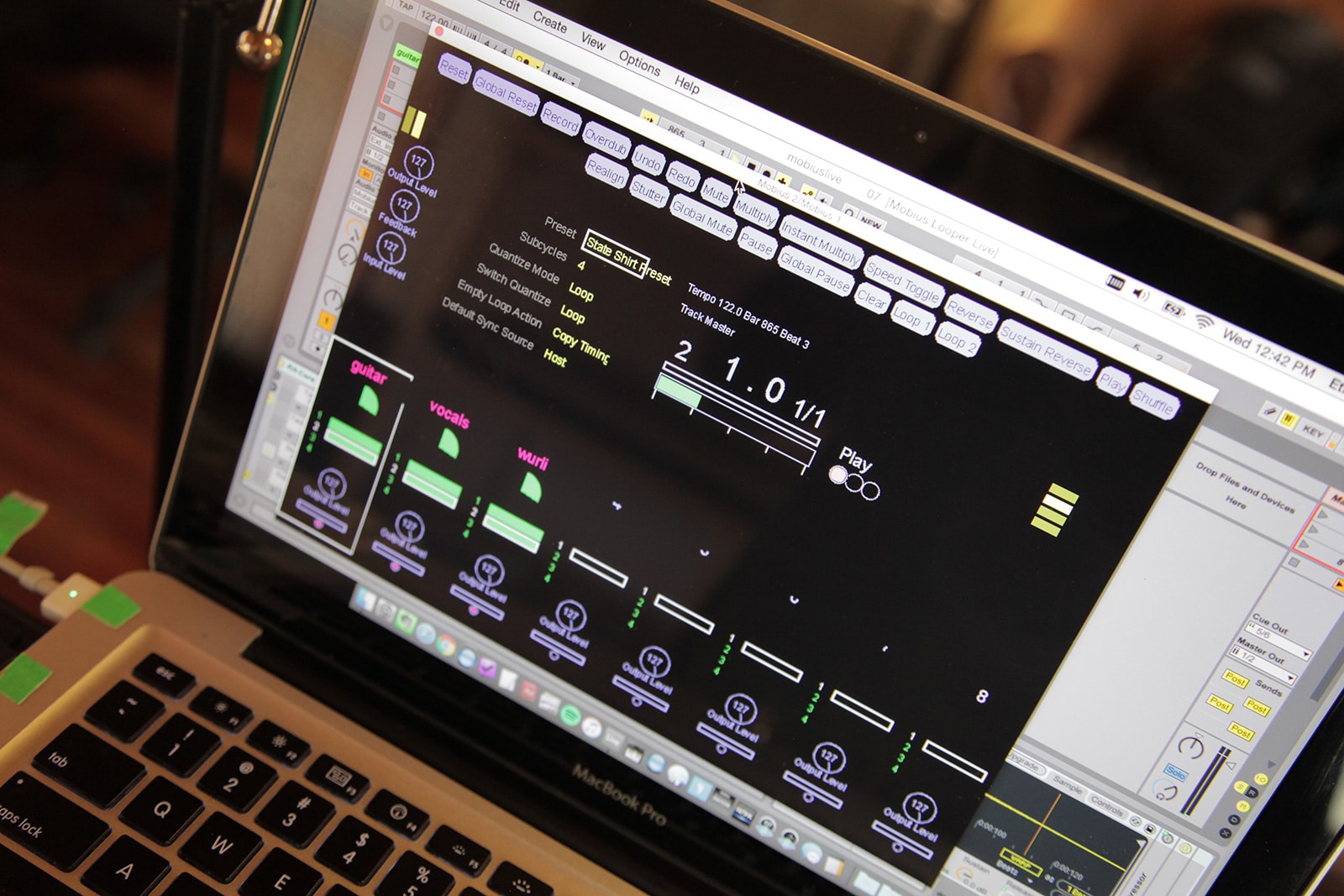
Yes, it’s certainly complicated, but it’s an insanely fun rig for live performances, and for messing around and creating weird looping improvisations.
EDIT: Ethan just put together a video that goes into his looping rig in a bit more detail. Check it out:
Below are a couple of Ethan’s videos that he has posted recently using this rig. Check out more of his videos, or listen to his latest album Lost Hills on Spotify.
Subscribe to our newsletter to be the first to hear about new Strymon products, artist features, and behind the scenes content!

In addition to being a co-founder of Strymon, Gregg Stock is the man behind the analog circuit design in every Strymon product. Recently, he was kind enough to

Strymon co-founder Pete Celi is responsible for the sound design and DSP algorithm creation for all the Strymon pedals that use DSP. Recently I had the

Hey there! We just put together a couple videos that demonstrate looping with our TimeLine delay. TimeLine Looper Basics In this first video, we go
33 Responses
Hi Angela and Ethan,
Fantastic write up. Mind boggling yet beautifully streamlined looping performance setup!
STRYMON “AMP IN A BOX” pedal!!! Please. Yes Please! I would love to have a simple but great sounding amp simulation pedal that would allow me to work faster. I have not enjoyed my years of experience with Fractal Audio or the other companies who cram so many amp models and parameters and constant updates into their devices. It’s a tweaker’s paradise and an artists’ nightmare for getting creative work done.
I would LOVE a pedal that had only the best and most important amp models with only the most useful features in a compact pedal.
Clean – Fender Twin
Crunch – Vox A 30TH
Lead – Marshall Plexi – JCM
Stereo Input option with internal jumper for more versatile placement of other STRYMON effects around it.
A 2×12 JBL Fender speaker cab
A 2×12 Alnico Blue Vox speaker cab
A 4×12 Celestion G12H Marshall cab
This would be a brilliant addition to many players boards who use STRYMON effects and want a great sound direct to the PA or in the Studio without having to haul an amp or Axe-Fx.
Thank you for listening!
Bob
Hey Bob, thanks so much for your comments. Glad you dig the rig! Thanks very much for your feedback. All of us here do find this prototype very useful, and the simple interface on a pedalboard is appealing to me personally. So it’s certainly something we could consider for production. Thanks again! 🙂
Ethan
I’m sure that many people will have questions about the proto “amp in a box” unit. It seems that the modeling tech is finally beginning to catch up to the professional’s needs. From my experience none of the modelers I have tried can truly replace real amps, but maybe your design could change my mind.
Just curious though…does this prototype model an actual amplifier/cabinet set, or is it just a cab filter like what we have seen from the Big Sky?
Hey Zachary, the prototype that we built was kept very simple for the Strymon Social event. Just one amp and one cab. You may remember that we used to build tube preamps branded as Damage Control—the amp and cab sound design for this box was inspired by those tube preamp circuits.
Ethan
Has anyone ever told you that you look like a young Tom Petty Ethan 🙂
What I meant to write before about the “Amp-In-A-Box” Strymon pedal is that the models below would be the essentials. I think most guitarists could find their tone or something close to it with these choices:
Fender Silverface Twin Reverb
Vox AC30 Top Boost with alnico blue speakers
Marshall Plexi – JCM900 with G12H speakers
Fractal has arguably the best quality amp/cab simulations. I personally think they are closer than Kemper or Atomic or Line 6 or Two Notes or Yamaha. The Fractal is a huge time investment with over 250 amp simulations to audition, many of which are completely redundant for a working live/studio musician/composer/engineer/producer etc.
I have used the Fractal technology since it’s inception almost a decade ago now and while after years of tweaking it can sound incredible, with the current version Axe-Fx II, it takes me many days just to dial up a new amp sound until I am satisfied that I have turned over every stone possible in search of the best possible tone. Sound uninspiring?
This time spent is not because there are no good sounds inside this box or that I am new to operating high end studio DSP hardware but rather because this is supposed to operate like a guitar amp which it very much does not. A guitar amp is a very simple piece of equipment to operate. Some great amps have only a volume knob on them.
Fractal is unfortunately a complete failure as a guitar amp simulator because there are way too many options and paramters that do not exist in guitar amplifiers unless you are building one from scratch by hand. How many successful artists do you know that build guitar amps in all of their creative time?
If you want to make music – songs, compositions, even ambient soundscapes, the Fractal Axe-Fx II is a creativity inhibitor. Your brain generates creative ideas at a certain speed. If you turn on the Axe-Fx, your creative idea is lost. It takes way too much time to translate that idea into this gear. The guy who invented the Fractal is nothing less than an EE wizard. His designs do not take into account the HUMAN FACTOR though.
The original SansAmp sounded great for it’s time. Today it sounds dated. But if you look at it’s design, you know why that device was so popular with professional working musicians all over the world. It’s probably still the most popular amp simulator used by professional working studio guitarists in all of history. While Fractal is continuously changing it’s firmware and trying to improve a rather poorly designed piece of “always in prototype mode” equipment, the SansAmp Classic was the same design for over 20 years and some people still swear by them because they are a creative tool for an artist.
None of the products below offer the highest level sound quality, creative integration and fun/easy workflow that artists require to put their ideas into action with professional results
Fractal Audio Axe-Fx
Fractal AX8
Line 6 Helix
Kemper Profiling Amp
Yamaha THR100
Atomic Amplifire
Tech 21 SansAmps
Amplitube
Two Notes Torpedo & LE preamp pedals
What I love about Strymon products is they are really fast to work with, even though the sound of them is extremely complex and deep. I find that I can dial up the sound that is attached to my creative idea right away and I don’t lose the idea in the process of dialing up the sound. Becuase of this, last year I stopped using the effects in my Fractal Axe-Fx entirely and I have been getting all my effects from my Strymon pedals both in the effects loop for post processing and before the stereo inputs of the Fractal. The Strymon effects sound better, especially the Big Sky Reverbs and they allow my creativity to flow naturally.
I think many people would love to have:
1. Fractal or beyond quality amp simulation of the three most used amps in the world in a compact pedal. You can’t please everyone but that would please most.
2. An amp simulation device that takes seconds to dial in without menu diving or apps on a smartphone they have to tap away on or zap into their guitar pickups to get a sound in the middle of a creative idea
3. Amp simulation that can go on their existing pedalboard – integrates with the setup they have already and solves the stage volume issues of many different types of gigs and studio situations while being ultra compact for travel gigs where taking a real amp is not an option
4. Stereo inputs and outputs for complete flexibility with other pedals
It would be a huge innovation to have something that worked as gracefully as the original SansAmp but used the modern day SHARC or TigerSHARC DSP. There isn’t anything that touches the quality of the Fractal/Kemper/Helix but is also fun and easy to use and affordable. I think an “Amp-In-A-Box” pedal or a Strymon mutieffects pedal with amp simulation would be an extremely creative tool and extremely hot all over the artistic world
“Amp-In-A-Box” is not an idea that should be a prototype or shelved. It’s a much needed tool that doesn’t exist….yet.
Funny story. Fractal’s Cliff Chase and our own DSP designer Pete Celi were actually college roommates!
I can’t comment on the likelihood of a product like this making it into production, but I do thank you again for your thorough feedback. We do always read through and consider all customer suggestions. It’s all good stuff. 🙂
Ethan
I agree with everything Bob said. Three amp models in a box designed to fit on a pedal board. It would be nice to have it midi switchable. This write up was great and gave me some ideas about how to better integrate my Strymon pedals with Logic. Of course this article also made me think about how great a Strymon all in one box would be. Especially if it could work as a processor for in-the-box plugins. Or maybe a partnership with Universal Audio to bring Strymon plug-ins to that platform. Anyhow keep up the great work.
Fascinating rig and very impressive looping abilities, Ethan! Playing keys & guitar at the same time is quite a feat. But more than anything, I’m struck by the amp-in-a-box prototype.
Bob explained the need for a simple-interface amp(s)-in-a-box pedal very well. A pedal like that would be incredible, especially for home practice with headphones. Stereo support and being able to output to the PA & an amp simultaneously would also be a huge plus.
Sign me up as a beta tester! 😉
Thanks for the kind words! 🙂 And thanks of the suggestions, we really appreciate it.
Ethan that is some great stuff!
i really would love to know more about how thats all hooked up. You certainly know your gear. i would love to figure out how to do this my self, been feeling really constrained by the ol’looper on the floor.
Again bravo, i find it inspiring.
a
Hey Andrew, glad you dig it! Did you have any specific questions about set up? Let me know and I’d be happy to help share what I know. If I can find some time I’ll try to put together a video on the setup.
Ethan
Nice!
Thanks Matthew!! 🙂
Hi Ethan,
With this setup, what synth bass software plugin do you use to “maintain low tones” in your musical adventures? Also, do you use the STRYMON DECO to treat the delay/reverb tail of your Timeline and Big Sky sounds with a stereo enhancer or stereo widening effect to make the reverb more spacious or do you use it to overdrive the reverb tail?
Very interesting about Pete Celi and Cliff Chase being college roomies. They are kind of like the Stephen Hawking and Roger Penrose of the guitar community. Hawking and Penrose collaborated on some pretty big ideas – general relativity and quantum mechanics which led to the latest research in science and cosmology.
Wouldn’t it be interesting if the leading scientist in the field of tube amp modeling quantum processing collaborated with the leading scientist in the field of integrated digital effects algorithm processes and intelligent user interface? A Fractal/Strymon “Amp/Effects-In-A-Box” would cement the legacy of two of audio engineering’s most brilliant minds and friends?
Hey Bob, I’m using one of the Ableton Live “Analog” basses. I believe it’s called “Woofer Loving Bass”. 🙂
Yes I do utilize Deco last in chain, to treat the delays and reverbs with subtle Tape Saturation, stereo widening, and tape-style modulation. Tape Saturation is usually set around 9am to give the sound a bit more edge. Bounce mode for a bit wider sound. Blend set fully clockwise (so you only hear the Lag deck) with Wobble around 2pm. I’m a fan of very aggressive modulation (a la Com Truise, Tycho) so that combo of Blend and Wobble really allow the tape modulation to manipulate your signal.
Interesting thoughts on Strymon and Fractal. 🙂 We’re fans of what they do and know a lot of people really dig their stuff. Can’t comment on any possibilities of working with other companies but always appreciate the suggestions and feedback!
Great setup!
I have been looking into Mobius. What do yo do about tempo? It doesn’t look like you have at tap anywhere for Live’s tempo. Are you tapping it through the Push and then somehow playing your first loop correctly to the time?
Thanks! 🙂 🙂
Much of the time I’m playing to a click, driven by Live. You can set Mobius looper to sync to ‘host’, which will lock it into Live’s tempo. Before each song I’ll set Live’s tempo for that particular song.
If you don’t want to play to a click, you can set Mobius looper sync source to ‘track’, which keeps Mobius tracks in sync but it won’t sync to Live.
I could be wrong but I generally don’t hear a click in the videos I’ve seen. Do you have an ear monitor?
Correct, when I play to a click I either wear headphones or in-ear monitors. 🙂
Ethan, thank you for the info!
May I ask why you enjoy Mobius more than Live’s looper? One reason I am considering Live’s looper is the multi-function Record button that allows one to record, play, overdub, undo and clear with just that one button whereas, after reading the various Mobius manuals, as far as I can tell, there isn’t the ability to assign more than one of these functions to a midi cc in Mobius.
I’m waiting on my midi controller to test both out (after having been using hardware loopers for over a decade) so I’m just curious why you prefer Mobius?
Also, have to say, I came across some of your videos last week while searching for Mobius examples and was quite impressed, so this article is timely!
Live’s Looper is nice, but not that useful to me because one instance is limited to one loop. I like to be able to quickly switch between multiple loops. You can use multiple Live Looper instances but I haven’t found an elegant way to switch back and forth between them. Mobius Looper is very good at switching between loops, and offers several ways you can do it. Though yes I’m not sure you can assign more than one function to a MIDI CC.
Thanks for checking out my vids, glad you enjoyed them! 🙂
I covet an amp-in-a-box like that.
Winning details:
1. You had me at that form factor: two switch pedal size is perfect
2. A good sound or two
3. No effects or feature diarrhea
4. Easy controls
If nothing else, it would be a great “plan B” for when the tubes don’t cooperate
I certainly get all the excitement over the amp-in-a-box pedal idea. Strymon reached a level of sound quality that made a lot of anti-digital effects guys change their minds. I was one (well, maybe not anti, but definitely pro-analog). I own a El Capistan and it is truly amazing (Deco is next). So, for many, while coming from other manufacturer the amp in a box thing would not be a great deal, given the quality of strymon simulations, a strymon pedal (or modeling amp head) like that would be a dream come true (because we assume quality will be as perfect as always).
Kemper has also finally reached a level of quality that meets pro expectations in sounds, but they are fairly expensive and most people don’t need a zillion amp sounds, but just good examples of the classic sounds other comments have mentioned above.
Sorry I diverged so much from the topic of your pedalboards (awesome and very creative friendly by the way), and yes, I am obviously feeding the hype so you make it because I think it could potentially be a game changer and I would love one!
I love Bob’s idea about amp in the box. I am in the same situation struggling because I need to find a quick solution to go amp-less and direct for my live gigs. It seems more and more artists use Fractal Audio Axe-FX II live but in my case I cannot justify the price and also I don’t want another frustration of spending and wasting my valuable creative time on programming the sounds. I know the Axe-FX sounds great but its complexity along with price is way beyond in what I want to invest.
I have made a decision and I know that I want to use a few analog pedals that would go to preamp and then to simple amp simulator with good quality speaker emulation. Right now I think only Two Notes Torpedo C.A.B. is something that could work for me.
I am planning to buy Big Sky so I could run it along with Timeline after the Torpedo C.A.B. and send the signal in stereo to the FOH mixer.
In this setup I need to use analog pedals that would give me a basic amp sound. So far I got Carl Martin AC Tone that gives me the AC30 Vox sound, and also I got Wampler Plexi Drive Deluxe that gives me Marshall sounds. I need still something to get me this Fender clean sound.
With the above I think I can get all needed sounds on my pedalboard.
But the idea of the amp-in-the box with three basic amps and good quality convolution based speaker emulations is still alive and i am waiting for it. If Strymon could build something like this for us, it would make some many people extremely happy.
Hopefully to see you at the NAMM 2017 in Anaheim in January.
Henryk
Highly enjoyable and incredibly effective demonstration of all the amazing tech available to us all….if we can only muster the patience and imagination to harness it.
Well done!!
Amp in a box? Yes please!
A single format version with a favorite switch would be easy to incorporate as a “channel switching” amp- vox to marshall or whatever. A Mobius/Timeline/Bigsky sized one could be setup with three amps per bank and switched via midi.
I still use a mic’d cab under the stage at church but I’m always on the lookout for a simple/great sounding rig for at home, flying gigs and as a backup.
I’m gonna go ahead and say it- please incorporate the ability to load external impulse responses!
Jamie
Thanks very much for the feedback! 🙂
hahahah, I forgot to mention. Ethan, awesome job! I was drawn here by listening to your vids then got distracted by gear, as one does….
Glad you enjoyed the vids! Thanks for checkin’ them out! 🙂 🙂
Het Ethan , cool rig ! Just wondering what your using to route all the midi controllers and midi to and from the vocal timeline and your pedal board ? Thanks!
Thanks James! My PreSonus audio interface has MIDI in/out, and I’m using that to send MIDI clock from Ableton Live to the TimeLines. By default TimeLine, Mobius, and BigSky will accept MIDI clock. I’m simply going MIDI OUT of the PreSonus to MIDI IN of the vocal TimeLine. Then to MIDI IN of the guitar TimeLine. The vocal TimeLine has MIDI THROUGH turned on to send the clock through to the guitar TimeLine on the floor. When I change a tempo in Ableton, it changes the delay time on both TimeLines.
I’ve also enabled TimeLine’s MIDI RST feature, which re-syncs the delay time back to the external MIDI clock source tempo after tapping in a new tempo or sweeping the time knob. That way I can do fun sweeps and bleeps with the Time knob but it will then return back to the sync’d tempo.
The other MIDI controllers are all USB. I have a D-Link USB hub and run most USB devices through that into the MacBook. The SoftStep and the Korg units have their own setup apps, and everything is routed within Ableton.
Hope that helps. Let me know if you have any other questions 🙂
So this got posted on geartalk’s instagram… and I can’t wait to find out if you guys will release that amp in a box pedal. I’ll get one in a heartbeat.